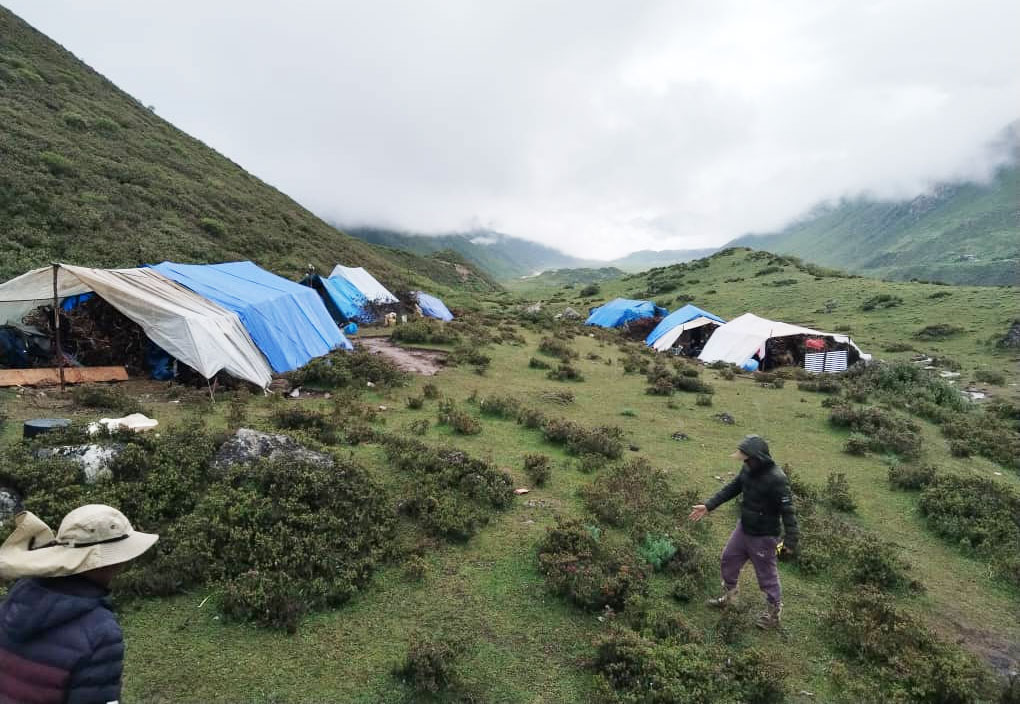
Located right below the mercurial Thorthomi Lake, the highland communities of Thangza and Toenchoe chiwogs in Lunana have lived in perpetual fear, the dark memories of the 1994 glacial lake outburst (GLOF) and the trail of devastation it left behind vivid in their minds.
Every summer, the residents of these villages move higher up to safer grounds, away from the dangers of a potential GLOF that could sweep away their entire village.
Much to their relief, some 80 households of Thangza and Toenchoe are getting permanently relocated to a new location this time.
The residents are currently staying in temporary tents in three locations of Damthangkha, Bayza-Gangjuk, and Dungbiteng, a few kilometres above their chiwogs. Once tsamdro (pasturelands), these lands are owned by the state.
Works on drinking water supply, toilets, and plot demarcation to provide 10 decimal of land each to the households are underway.
The decision to relocate the highland communities follows the National Centre for Hydrology and Meteorology’s (NCHM) recommendation after recent GLOF incidents. Earlier this year, the Gasa dzongkhag and gewog administrations, in consultation with relevant stakeholders and residents, decided to relocate the highlanders to a safer place.
As semi-nomadic communities, people of Lunana migrate to higher altitudes during summer and autumn months for grazing and collecting cordyceps.
This practice is typically crucial for highlanders of Thangza and Toenchoe chiwogs. Even if they do not migrate to higher altitudes for grazing, they abandon their villages for safer locations due to the fear of potential GLOF from Thorthomi. The highlanders return to their homes in winter when the glacial lakes freeze.Lunana Gup, Kaka, said that the people of Thangza and Toenchoe were happy because they finally had a place to call their own in the new village. “It was often difficult for them to relocate temporarily on state land during summer and autumn earlier.”
He said that although there is an early warning system for flood in Thorthomi, Thangza and Toenchoe were only a few kilometres downstream. “In the event of a flood, this will provide little to no time for evacuation, which is why relocation was important.”
The construction of proper houses at the new location is likely to take some time. The houses in Tenchoe and Thangza took at least 10 years to construct. “For the new village to take shape, it will take a minimum of 10 years, as it is very difficult to find labour, transport materials, and build houses in the highlands,” Kaka said.
Why is Thorthomi the most dangerous glacial lake?
Among Bhutan’s 17 potentially dangerous glacial lakes, Thorthormi is considered the most dangerous. This is primarily because it is at a higher elevation than Raphstreng Lake, separated by a fragile moraine dam. If Thorthomi were to burst, it could trigger a catastrophic chain reaction, causing an overflow into the adjacent Raphstreng Lake.
Unlike other potentially dangerous glacial lakes in Bhutan, which are isolated and not in proximity to other lakes, Thorthomi’s position makes it particularly hazardous.
The moraine dam between Thorthomi and Raphstreng has been deteriorating over the years. A moraine dam is a natural barrier formed by rocks, debris, and sediment deposited by glaciers, which can block water and create glacial lakes.
The Chief of the Cryosphere Services Division, Karma, said that the stability of the moraine dam is one of the crucial factors to prevent GLOFs as GLOFs are caused and triggered by other external factors as well. “The moraine dam itself is made from unconsolidated materials, meaning it is not strong material to begin with. If the moraine dam diminishes in size, there is a threat that the barrier would collapse and Thorthomi could overflow into Raphstreng and cause a GLOF.”
A study by the NCHM estimates that in a worst case scenario, the collapse of the Thorthomi moraine dam could release a flood volume of 53 million cubic metres of water, the result of the combined GLOF from Thorthomi and Raphstreng Lakes. Should such a convergence occur, Punakha would face a flood nearly three times more severe than the 1994 GLOF.












